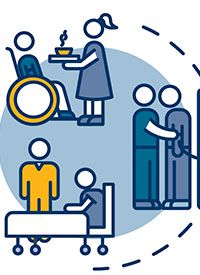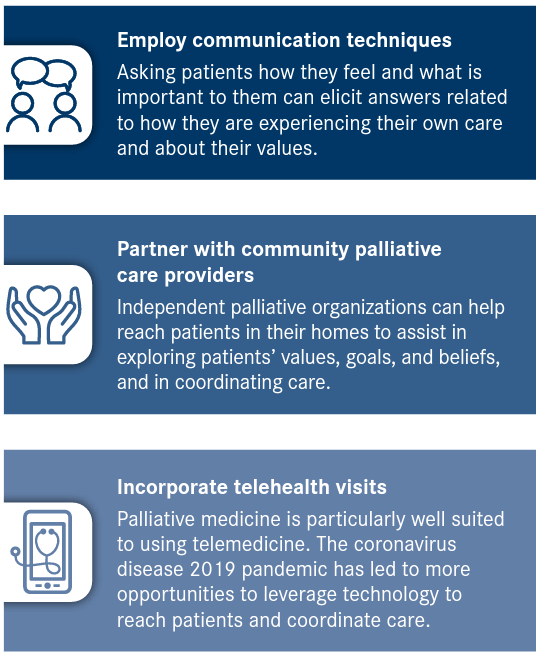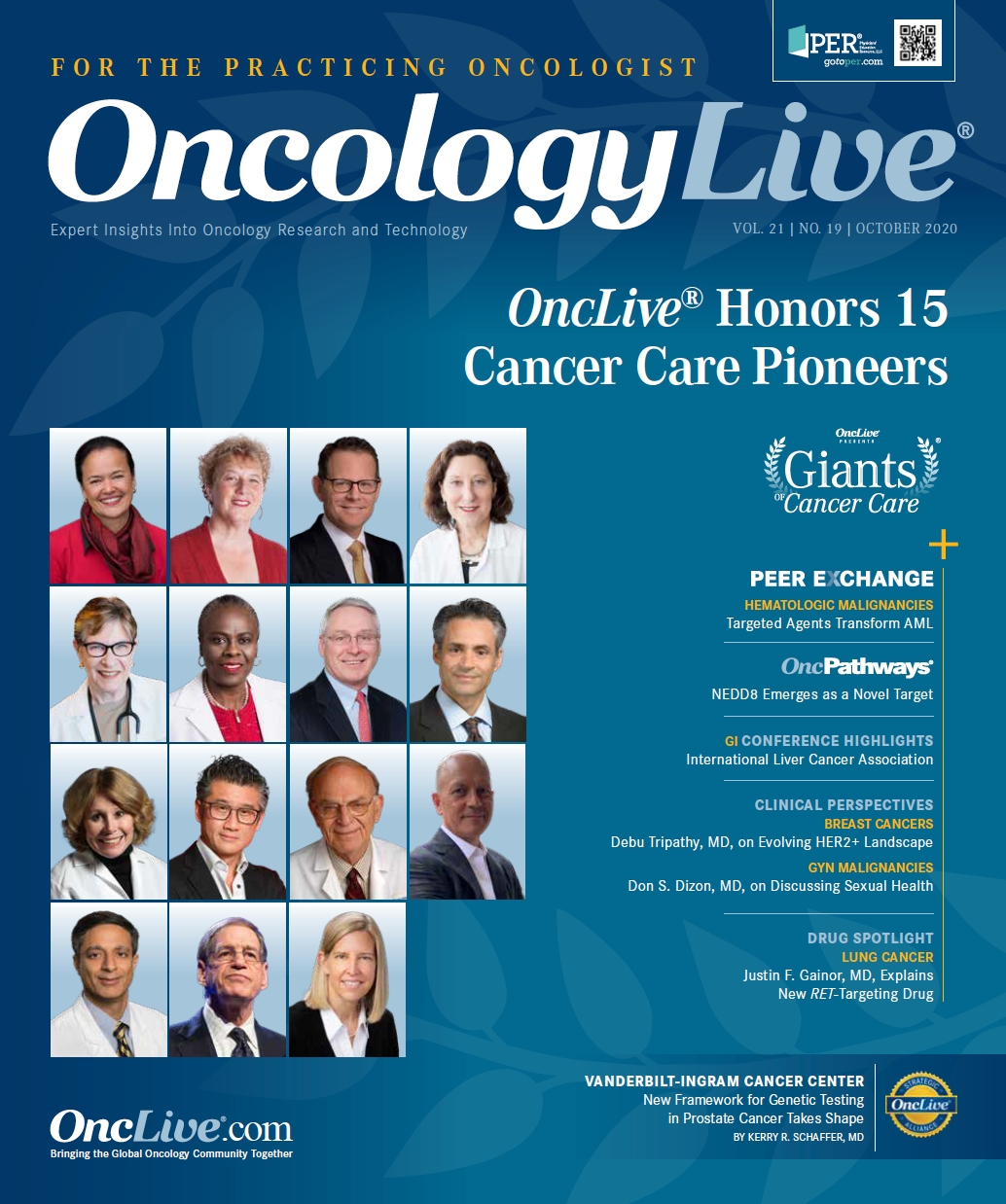Publication
Article
Oncology Live®
Palliative Care Can Address Gaps in Oncology Landscape
Author(s):
Palliative medicine has evolved to become a standard for high-quality cancer care, helping patients relieve suffering throughout their journey, improving quality of life, and prolonging survivorship.
palliative care

Palliative medicine has evolved to become a standard for high-quality cancer care, helping patients relieve suffering throughout their journey, improving quality of life (QOL), and prolonging survivorship. Palliative care providers can address issues related to treatment adherence, unrecognized symptoms, financial issues, and caregiver burden.1
Guidelines from the American Society of Clinical Oncology (ASCO) recommend integrating palliative care into oncology care. Providing patients with this service can help oncology practices excel in the valuebased world, but many community practices struggle with implementing this specialty. However, some viable, cost-effective strategies can allow practices of all sizes to offer these valuable services.
Challenges of Adding Palliative Services
Reimbursement is the most significant obstacle practices face when trying to offer palliative care. Many palliative services are time intensive, so these specialists cannot see as many patients in a day as the average provider. Consequently, they cannot fully pay for themselves in a fee-for-service (FFS) model. The financial value of what they offer is the savings from reduced resource utilization at the end of treatment, when costs are highest.
Large organizations can redirect resources from bundled payment programs or other initiatives such as the Oncology Care Model (OCM) to fund these extra services. In fact, 94% of hospitals with more than 300 beds and 72% of hospitals with more than 50 have palliative care beds.
Unfortunately, this is not an option for smaller or most medium-size community practices or those in rural areas, because they simply do not have access to the same level of funding as larger practices. Even though health care is transitioning to value-based care, most of the services physicians provide are still reimbursed by FFS. With this structure, it is challenging for many practices, especially those in a community setting, to develop their own palliative care programs.
Staffing is also an issue. Training capacity is insufficient to keep up with population growth and demand for palliative care services. Currently, there is just 1 palliative care physician per 1200 people who have a serious illness in the United States. In oncology specifically, there is just 1 palliative care physician per 141 oncologists.2
Research suggests that by 2030, just 1 palliative care physician will be available for every 26,000 patients. Similar shortages are predicted for nurses, social workers, and spiritual care providers with training in palliative care.
Lastly, changing the mindset of some oncologists and adjusting practice workflows can be problematic. Palliative care is a relatively new field, and some physicians who have not had exposure to this specialty may lack an understanding of the benefits these services provide. Additionally, established workflows are difficult to alter.
A Wealth of Benefits
Providing expert and timely symptom management for patients with high symptom burden improves a patient’s QOL and satisfaction. The findings of 1 study of patients with non–small cell lung cancer revealed that early palliative care led to improvements in QOL and mood, as well as increased survival by an average of nearly 3 months.3 In another study at a cancer care center, results showed fewer hospital admissions and emergency department visits and reduced intensive care unit use, as well as lower direct costs of inpatient care in the last 6 months of life.4
Palliative care services can also be a differentiating factor in the market, positioning the practice as a leader in palliative medicine. Physicians benefit, as well, because they can focus more on treating the patient’s disease rather than managing symptoms.
Study findings show that palliative medicine reduces the cost of care. The most recent study to add to this growing body of evidence measured the total cost of care (TCOC) for patients with cancer who received less than 3 days of hospice care at the end of life compared with those who received 3 days or more.5 The study, conducted by researchers across The US Oncology Network, analyzed 7329 deaths that occurred with patient who had Medicare and were enrolled in the OCM who died while under the care of practices in the network. The results reinforce previous studies regarding TCOC in the last 30 days of life, finding that dying in the hospital cost twice as much as dying at home under hospice care ($20,113 vs $10,803).5
Palliative care enhances survivorship by iberating patients from suffering, providing a better QOL, and allowing more access to an oncologist. Unfortunately, there is an ongoing misunderstanding of what palliative care is and when patients should start receiving these services. Because many think it pertains only to the very end of life, it is essential to educate providers and patients about the benefits of early intervention.
Ideally, a connection with a palliative care specialist should occur at the time of diagnosis so that the road to survivorship is as smooth as possible. Today there is a greater awareness of the value of these services in oncology, and the need is growing. Changing paradigms in delivery reimbursement and virtual technology are leading to increased access, enabling many more patients to have the best possible experience during their cancer journey.
Establishing Best Practices
Ideally, cancer centers have an in-house (embedded) program. At a minimum, their interdisciplinary palliative care team should include a dedicated physician, nurse, and social worker. Other key specialists include dietitians, chaplains, counselors, pharmacists, rehabilitation specialists, and physical therapists. Offering these services in-house is ideal for patients because it provides better communication, continuity of care, and focused mission.
In-house providers can access palliative care specialists practically anywhere via virtual technology. These specialists can provide actual supportive care services, as well as guidance and mentorship. Some practices in the network with numerous sites have plans underway to use technology to bring palliative care to their locations that do not have access to these resources. This approach is also viable for small or medium centers with limited funding. Expensive diagnostic video equipment is not necessary for a high-quality encounter.
Another option is to partner with other palliative medicine specialists. In most communities, cancer centers can partner with palliative medicine specialists and organizations to provide seamless palliative care services. Hospice is always a good choice, offering skilled specialists who can provide these services in addition to traditional hospice care. Academic institutions make good partners because they have vast resources, enabling them to offer a wide range of services. Many hospital systems also provide these services, as do some insurance companies.
Recognizing the funding obstacles encountered when adding palliative care, The US Oncology Network has taken an innovative approach to solving the problem by developing a nurse practitioner (NP) program model. A pilot program underway in several practices across the network uses NPs who are certified in palliative care and social workers who have expertise in the field. Program costs are much lower because it is built around NPs rather than physicians. Medical oncologists do play a role in prescribing medications, but their time commitment is minimal. This model enables practices to start a program on a smaller scale and, based on volume, slowly grow it until there is justification for hiring a physician.
One practice that has piloted a palliative care program is Oncology Hematology Care (OHC) in Cincinnati, Ohio. Two NPs received training in palliative care in the summer of 2019, and the organization implemented its program in October 2019. To prepare for this launch, OHC created symptom pathways and note templates in the emergency medical record and provided education about palliative care and the program to physicians, nurses, navigators, and the front desk staff. The practice targeted all patients with stage IV disease and with pancreatic and brain tumors. They started with 2 palliative care appointments each week per advanced practice provider. By February 2020, they were offering palliative care in 3 of their regions.
Another member of the network, New York Oncology Hematology (NYOH) in Albany, had an NP start seeing patients in palliative care earlier this year, working with a medical oncologist, as a pilot. NYOH also partnered with an outside palliative care program and worked closely with an NP and a social worker (both certified in palliative care). The program was successful enough that NYOH decided to embed it into their practice, and the NP and social worker joined NYOH in July.
Figure. How Community Oncologists Can Provide Palliative Care1

Ellen Gokey, director of palliative care at NYOH, said they are focusing on following metrics, including discussion and documentation of advanced directives, time from diagnosis to time of referral to palliative care, pain management, and hospice referrals.
“We will also be focusing on initiatives to decrease hospital admissions and emergency room visits by focusing on symptom management,” she said. “Our goal is to continue to educate providers and staff regarding the importance of incorporating palliative care earlier in the disease trajectory in order to establish a trusting relationship with the patients and work on improving their quality of life while they are receiving disease-modifying treatment. We will be providing palliative care in all of our locations and hope to continue to add to the team to incorporate [members from] other disciplines who are also certified in palliative care.”
Quan T. Dang, MD, is a palliative medicine physician with Texas Oncology, a practice in The US Oncology Network, and Lydia Mills is a senior manager of palliative care and social work at McKesson.
References
- Back A, Friedman T, Abrahm J. Palliative care skills and new resources for oncology practices: meeting the palliative care needs of patients with cancer and their families. Am Soc Clin Oncol Educ Book. 2020;40:1-9. doi:10.1200/EDBK_100022
- Bringing palliative care to more people. Cambia Health Foundation. Accessed August 18, 2020. https://bit.ly/34certA
- Temel JS, Greer JA, Muzikansky A, et al. Early palliative care for patients with metastatic non-small cell lung cancer. N Engl J Med. 2010;363(8):7330742. doi:10.1056/NEJMoa1000678
- Scibetta C, Kerr K, Mcguire J, Rabow MW. The costs of waiting: implications of the timing of palliative care consultation among a cohort of decedents at a comprehensive cancer center. J Palliat Med. 2016;19(1):69-75. doi:10.1089/jpm.2015.0119
- Hoverman JR, Mann BB, Phu S, et al. Hospice or hospital: the costs of dying of cancer in the Oncology Care Model. Palliat Med Rep. 2020;1(1):92-96. doi:10.1089/pmr.2020.0023





























%20(2)%201-Recovered-Recovered-Recovered-Recovered-Recovered-Recovered-Recovered-Recovered-Recovered-Recovered-Recovered-Recovered-Recovered-Recovered-Recovered-Recovered-Recovered.jpg?fit=crop&auto=format)
%20(2)%201-Recovered-Recovered-Recovered-Recovered-Recovered-Recovered-Recovered-Recovered-Recovered-Recovered-Recovered-Recovered-Recovered-Recovered-Recovered-Recovered-Recovered.jpg?fit=crop&auto=format)
